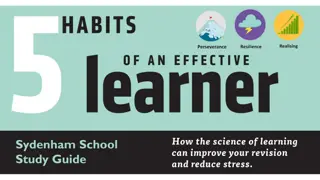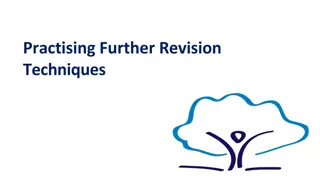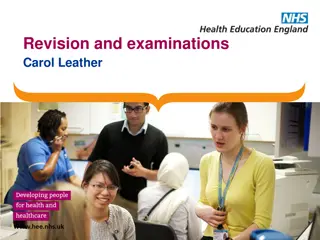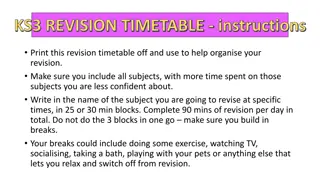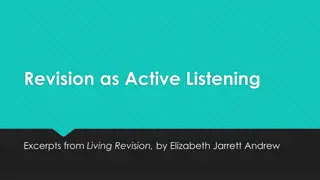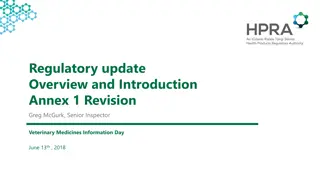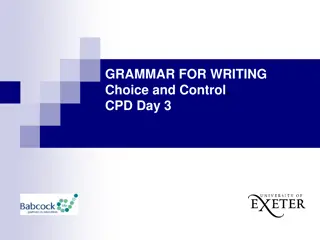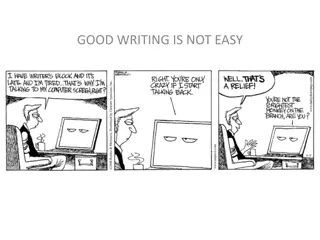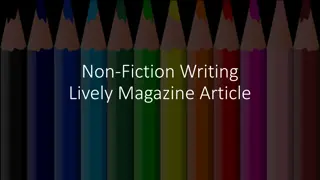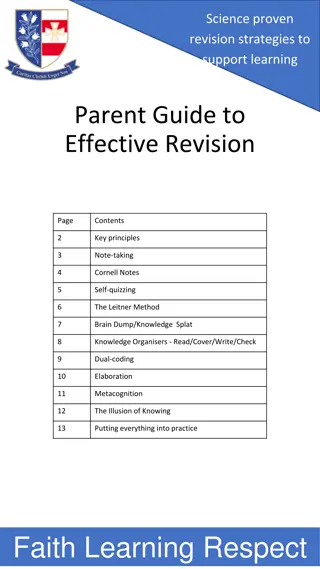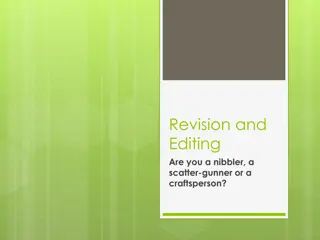Mastering Revision: Strategies for Enhancing Your Writing Process
Explore advanced revision strategies such as reverse outlining to improve your writing by analyzing content structure, identifying key elements, and enhancing flow, leading to more effective and engaging writing outputs.
Download Presentation

Please find below an Image/Link to download the presentation.
The content on the website is provided AS IS for your information and personal use only. It may not be sold, licensed, or shared on other websites without obtaining consent from the author.If you encounter any issues during the download, it is possible that the publisher has removed the file from their server.
You are allowed to download the files provided on this website for personal or commercial use, subject to the condition that they are used lawfully. All files are the property of their respective owners.
The content on the website is provided AS IS for your information and personal use only. It may not be sold, licensed, or shared on other websites without obtaining consent from the author.
E N D
Presentation Transcript
REVISION STRATEGIES Graduate Writing Center University of Vermont January 2021
TODAYS GOALS Share what makes re-visioning difficult and try Reverse Outlining to see the bones of a draft Use Color-Coding to make patterns visible Share your findings and further tips for adventurous, big- picture revision
YOUR PROJECT, YOUR GOALS, REVISION STRUGGLES What is your project? What are your big goals (your hopes and dreams) for this project? What kind of revision work does this project need to reach toward those goals? If you find revision easy, how and why? And if you find it hard, why and why? Respond in chat or type hand to unmute and share!
REVERSE OUTLINING You may have learned to make outlines before you start to write: a skeleton view of what you plan to write. With Reverse Outlining, you create an outline after the fact: a skeleton view of what you actually wrote. Use Reverse Outlining with a draft or portion of a draft if you feel your writing is all over the place, lacks flow, is repetitious, or is missing something.
REVERSE OUTLINING, EXAMPLE: Par 1: To convert difficult classroom experiences into learning experiences, teachers have to get beyond swapping anecdotes Par 2: Reflection seems key but widely used reflective practices are too free-form to ensure learning from difficulty and discomfort Par 3: Gibbs Reflective Cycle may provide the needed structure Par 4: Introduces Gibbs and goal of a reflective practice that points toward Next time I will
REVERSE OUTLINING, STEP 1: Read each paragraph of your draft or a section of your draft and ask, What s the gist? Write each gist in a column on a separate sheet of paper or in a separate document. If there s more than one gist in a paragraph, list them all. Aim to be specific as possible. Too general: Par 1: Introduces Myc More specific: Par 1: Introduces challenge of developing Myc therapy to stop tumor growth
REVERSE OUTLINING, STEP 2: Look at the column of gists, your skeleton s view of your draft. Questions you can ask of your outline include Do readers get the information in the order they would need it? Is there another way to order my points? Am I bringing up topics, moving to other things, then returning to those topics? Is that intentional? Did I repeat myself? Did I leave anything out? Do I have any paragraphs with multiple gists that could be broken up/developed as separate paragraphs? Are all of these parts relevant? Do I need to spend more (or less) time on anything? How much time did I spend on other people s ideas vs. my own?
COLOR-CODING Color coding helps you highlight aspects of a draft s structure you re interested in. For instance: To make sure you re leading with strong topic sentences rather than burying key ideas, use a highlighter to see where in each paragraph the main idea appears. To see how much time you spend on summary v. analysis or how much on others findings v. your own, choose one color to highlight the first and another to highlight the second. To see how a literature review could be reorganized by theme rather than by article/author, choose a color for each theme or concept. Use highlighters to see how frequently you hedge qualify or soften your claims or whether you have any too-strong that may need to be softened.
EXAMPLE: COLOR-CODING TO IDENTIFY A PARAGRAPHS TRUE TOPIC SENTENCE & BURIED CONTRIBUTIONS There has been a growing interest in nineteenth-century geographical representation. At the same time, no geographer has seriously examined the remarkable discourses that emerged during the latter half of the century to represent the geographies of worlds beyond Earth. Popular histories of geography (e.g. Sheehan 1996; Morton 2002) indicate that astronomers collected extensive geographic data about the nearby planets, usually recording their findings in detailed maps that were strikingly similar in appearance to many of the well-studied imperial maps produced during the same time period .
EXAMPLE: COLOR CODED-GUIDED REVISION Despite the growing interest in nineteenth-century geographical representation, no geographer has yet seriously examined the remarkable discourses that emerged during the latter half of the century to represent the geographies of worlds beyond Earth. Popular histories of geography (e.g. Sheehan 1996; Morton 2002) indicate that astronomers collected extensive geographic data about the nearby planets. Central to this study is how they typically recorded their findings in detailed maps strikingly similar in appearance to many of the well-studied imperial maps produced during the same time period .
COLOR-CODING What question do you have about your draft s structure? What pattern do you want to make visible through color-coding? Highlight each paragraph s main idea to see where it is placed? Highlight summary v. analysis or claims v. evidence or others research (or voices) v. own research (or voice)? Highlight themes/concepts to see how a lit review or discussion might be reorganized? Highlight hedges, softeners, and boosters accompanying claims? Something else .? Once you ve completed highlighting, you can look at how the colors are distributed or what the highlights reveal and make decisions about needed reorganization or revising.
BREAKOUT ROOMS What you learned through your reverse outlining and/or color-coding Revision questions and struggles you still have and strategies that could help Your next steps Questions and advice to bring back to the whole group
NEXT STEPS Quick intro to Teach It to Me strategy Tomorrow s workshop: Editing for Clarity and Cohesion Make an appointment with the Graduate Writing Center: uvm.mywconline.net Download guide to Revising and Reorganizing : visit https://www.uvm.edu/gradwriting/writing-resources and click on Revising and Editing
NEXT STEPS Take this super short feedback survey: https://tinyurl.com/yyj8hx5z




